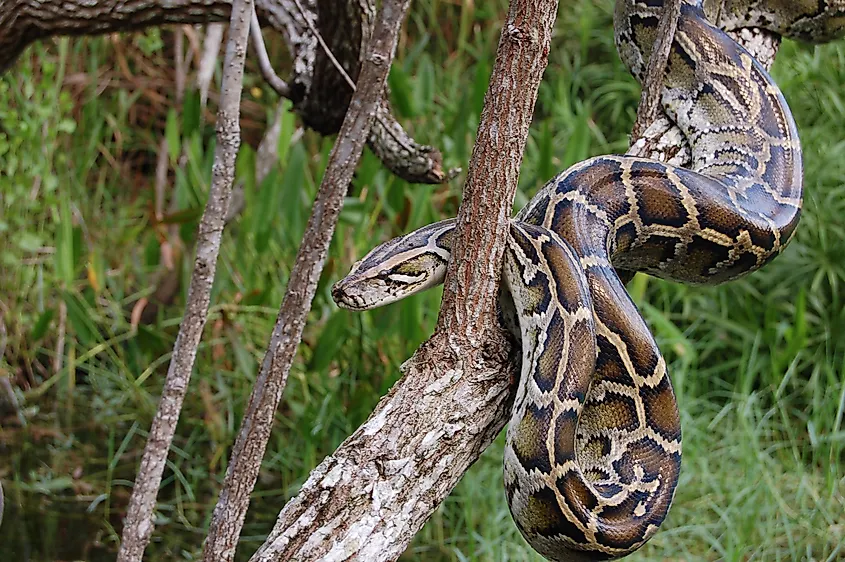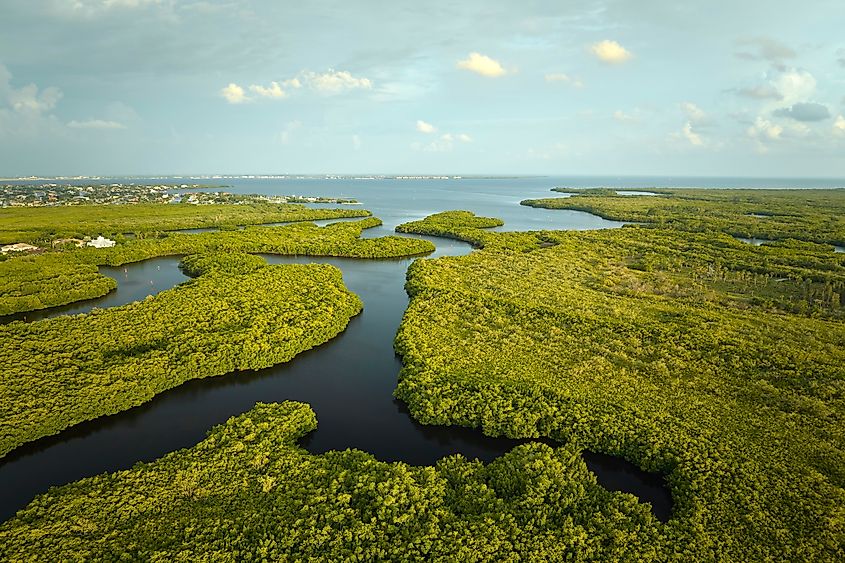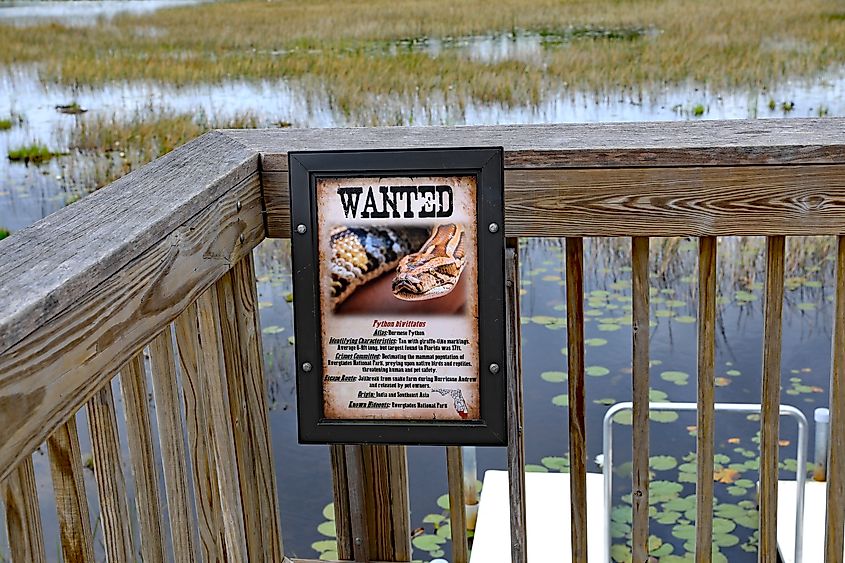
How Burmese Pythons Took Over the Florida Everglades
At twenty feet long and 200 pounds, Burmese pythons (Python molurus bivittatus) are formidable predators. But unlike in Southeast Asia, where their populations are struggling, the invasive varieties within the Florida Everglades have been thriving for generations. The Sunshine State's first wild specimen was caught in 1979, but this was far from an isolated incident. In subsequent decades, escaped and intentionally released pythons have continued to find their way into America's largest subtropical wilderness (and are inching toward major cities), where they feed and breed uncontrollably. Despite the best efforts of hunters, scientists, and government authorities, hundreds of thousands of these constrictor snakes are choking the life out of this delicate ecosystem. This is the story of how Burmese pythons took over the Everglades.
How Did Pythons Get Into The Everglades?

Burmese pythons have slithered their way into the southern third of Florida via two main sources. The exotic pet trade is the primary culprit, but 1992's Hurricane Andrew also played its inadvertent part.
Exotic pets, whether they are obtained legally or illegally, comprise a billion-dollar industry in the United States. Everything from lions, to monkeys, to venomous critters, and of course, large snakes are in demand. This national trend can be traced back to about the 1920s, but the sale of Burmese pythons in Florida saw a marked boom in the 80s. Then, between 1996 and 2006, upwards of 100,000 baby Burmese pythons were imported into the U.S. - many of them destined for Florida.
As the number of pythons in American homes increased, so too did the cases of escaped and abandoned juggernauts. For you see, these once-adorable babies become some of the largest snakes in the United States - easily overwhelming most living spaces and owners (not to mention racking up a grocery bill similar to that of a small family). Feeling that they have no other choice (especially once the state of Florida banned private ownership of invasive reptiles), pet owners simply release them into the wild - in many cases, to the vast, dense, and unchecked wilderness of the Everglades.
Hurricane Andrew, a category 5 storm that struck southern Florida in August of 1992, also contributed to the Everglades' increasing python gene pool. As if 65 fatalities and $27.3 billion dollars in damage was not enough, Hurricane Andrew also destroyed a local breeding facility, thereby releasing scores of Burmese pythons directly into the surrounding wetlands. It's worth noting that Andrew, and many subsequent seasonal storms, have likely released one-off snakes as they destroyed homes, and the flimsy animal cages within.
Why Do Burmese Pythons Thrive in the Everglades?

Hurricanes and exotic pets are not confined to southern Florida, so one would be right to wonder why the Everglades, in particular, has become such a breeding ground for Burmese pythons (and now even anacondas). This is where Florida's unique geography works against it. The 1.5 million acres that constitute today's Everglades (it used to be double that) occupy a subtropical region that is unapologetically wild. Yes, Everglades National Park is a popular tourist attraction, but its infrastructure barely scratches the wet and grassy surface. Snakes native to the jungles of Southeast Asian and South America fit right into this ecosystem. There are infinite places to hide, plenty of animals to eat (for now), and no natural predators to contend with. Southern Florida is also immune to winter. Nice as the northern reaches may be for most of the year, temperatures approaching near-freezing eventually descend, and even the occasional snowfall does occur.
Furthermore, given their finely tuned ambush tactics, and voracious appetites to boot, Burmese pythons are blamed for having reduced the population of several small mammals native to the Everglades by anywhere from 88% to 99%. In fact, the South Florida Water Management District estimates that in order for one Burmese python to reach 13 feet over the span of five to seven years, it would have to consume something like: one raccoon, one opossum, four five-foot alligators, five American coots, six little blue herons, eight ibises, ten squirrels, 15 rabbits, 15 wrens, 30 cotton rats, and 72 mice. Multiply that hypothetical diet by the 100,000 to 300,000 Burmese pythons that are currently estimated to live in the Everglades, and an obvious problem presents itself.
The theme surrounding the Everglades python invasion is escalation. Case in point, as smaller animals are extirpated, these fruitful and adaptable snakes turn to bigger and bigger meals. As previously mentioned, juvenile alligators are very much on the menu, but recently, scientists even observed a 15-foot female python swallowing a 77-pound white-tailed deer…whole! That's approximately 67% of its own mass in a single sitting.
The known territory of Florida's pythons is also expanding. Back in the early 2000s when only a few hundred were known to exist in the wild, they were confined to Everglades National Park (in Miami-Dade County). Burmese pythons are now known to occur from Key Largo to just south of Lake Okeechobee, and from western Broward County to Collier County. Evidently, the entire Everglades region (which includes not only the national park, but also Big Cypress National Preserve and three water conservation areas) presents a plethora of opportunities for these apex predators.
What Is Being Done To Suppress the Python Problem?

Even though Burmese pythons are amazing creatures - ones that feel pain and are simply trying to survive in whatever environment they find themselves in - the hard truth is that humans must intervene in order to restore balance to the Everglades. At this point, it is not clear that hundreds of thousands of powerful, well-camouflaged, and quickly-reproducing apex predators can be eradicated. But there are a few strategies in play.
The first step is to stop the bleeding. As of 2012, the United States banned the import of Burmese pythons, and as of 2021, Florida has made it illegal for anyone to own, buy, or sell one of these snakes (along with other problematic species). Those who had a pet python before the rule change are allowed to keep it, but are required to register it with the state, and have a microchip implanted. In order to prevent ongoing pet owners (whether legal or illegal) from abandoning their untenable animals, Florida Fish and Wildlife has established a no-questions-asked Exotic Pet Amnesty Program. The Floridian government has also set up a reporting system for anyone who spots an invasive animal or plant (use the IveGot1 mobile app, visit IVEGOT1.org, or call 1-888-IVE-GOT1). Concerned citizens can send up a signal, and the proper authorities will move in from there.
The next step involves abating the rapid expansion of wild python populations. To do this, males are tagged with radio transmitters so that researchers can follow them to breeding females. Since female pythons are capable of laying upwards of 100 eggs per year, each one that is removed (and subsequently euthanized) tilts the ecosystem back towards equilibrium. Scientists are also experimenting with gene and pheromone manipulation in order to disrupt the direction of flow. Unfortunately, given the extent of the problem, a third, final, and much more drastic strategy is required: mass killing.
South Florida has relaxed its laws so that anyone can humanely kill non-native reptiles on 32 Commission-managed lands, or on private land when permission has been granted by the owner. Otherwise, no permit is required, and even a hunting license is superfluous. The only protective measure in favor of Burmese pythons is one against unnecessary cruelty (a two-step stipulation that necessitates the animal immediately lose consciousness and its brain be destroyed). Those competing in the annual Florida Python Challenge must practice said humane methods. This year, 857 participants removed 195 invasive pythons from the Everglades throughout the ten-day August challenge. Ronald Kiger won the $10,000 grand prize by catching 20 pythons.
Sicking massive snakes loose on the Everglades has proven to be devastating for this National Park, World Heritage Site, International Biosphere Reserve, and Wetland of International Importance. Oddly enough, Burmese pythons are not the world's largest invasive species, but they are certainly one of the most overwhelming. Hopefully the changes in local laws, public awareness, and ongoing mitigating strategies will help plateau the runaway trend. But given how stealthy, well-adapted, powerful, and rapacious they are, Burmese pythons are likely to maintain their stranglehold on southern Florida for generations to come.











